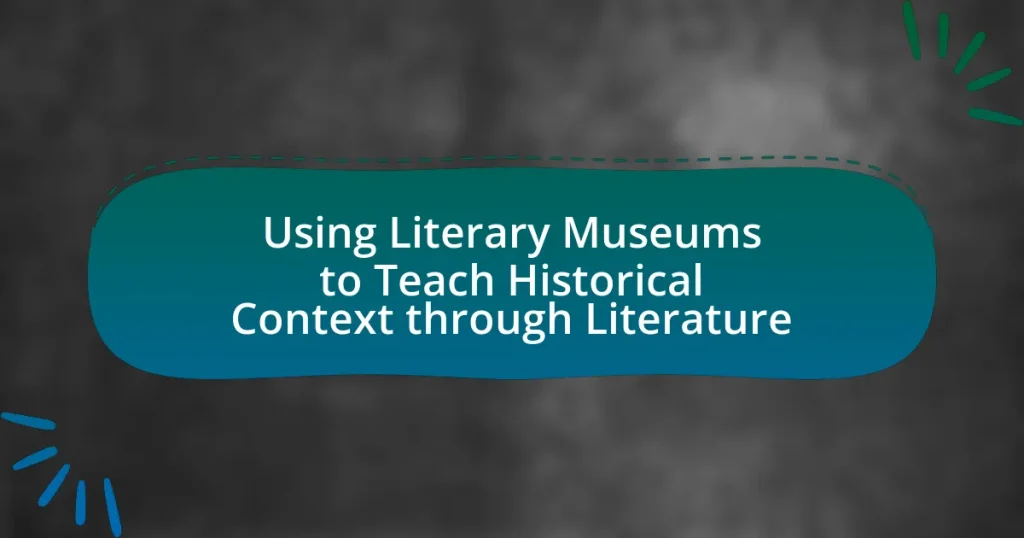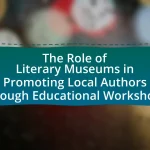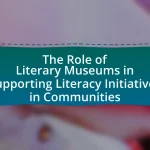Literary museums are institutions that preserve and showcase the works and lives of authors, providing educational insights into the historical contexts of literature. This article explores how literary museums enhance understanding of historical context through exhibits that include manuscripts, artifacts, and interactive programs. It discusses the importance of these museums in education, their role in fostering critical thinking, and the challenges educators face when integrating museum visits into curricula. Additionally, it highlights best practices for utilizing literary museums effectively, emphasizing the connection between literature and historical events to enrich students’ learning experiences.
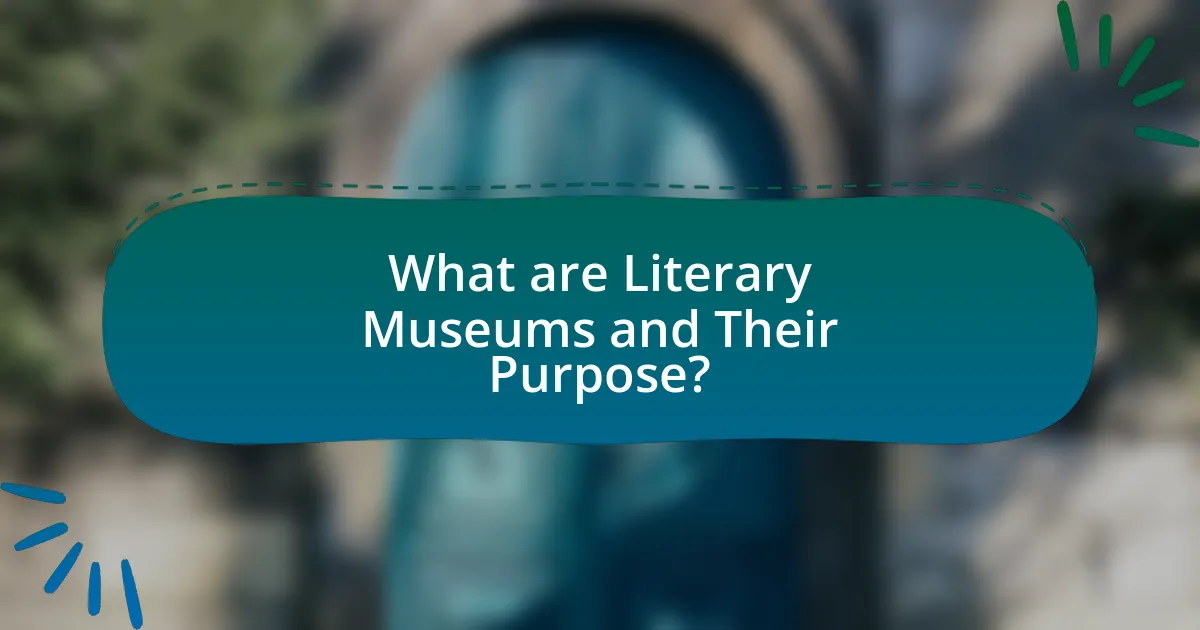
What are Literary Museums and Their Purpose?
Literary museums are institutions dedicated to preserving and showcasing the works, lives, and historical contexts of authors and literary movements. Their purpose is to educate the public about literature’s role in society, culture, and history, often through exhibitions, manuscripts, artifacts, and interactive programs. For instance, the Ernest Hemingway Home and Museum in Key West provides insights into Hemingway’s life and the historical backdrop of his writing, illustrating how personal experiences and societal events influenced his work. This educational focus helps visitors understand the connections between literature and the historical contexts in which it was created.
How do Literary Museums contribute to understanding historical context?
Literary museums contribute to understanding historical context by providing tangible connections between literary works and the socio-political environments in which they were created. These institutions often showcase original manuscripts, personal artifacts, and multimedia exhibits that illustrate the lives of authors and the historical events influencing their writing. For example, the Ernest Hemingway Home and Museum in Key West offers insights into Hemingway’s experiences during World War I and the Spanish Civil War, which shaped his literary themes. By contextualizing literature within its historical framework, literary museums enhance visitors’ comprehension of the cultural and historical significance of the works displayed.
What types of exhibits are commonly found in Literary Museums?
Literary museums commonly feature exhibits that include manuscripts, letters, and personal artifacts of authors, as well as interactive displays that highlight the historical context of their works. These exhibits often showcase original drafts, first editions, and biographical information that provide insight into the authors’ lives and the eras in which they wrote. For example, the British Library houses manuscripts from notable authors like Virginia Woolf and Charles Dickens, illustrating their contributions to literature and the social issues of their time. Additionally, many literary museums incorporate multimedia presentations that engage visitors with the historical backdrop of the literature, enhancing the educational experience.
How do these exhibits reflect the historical periods they represent?
Exhibits in literary museums reflect the historical periods they represent by showcasing artifacts, texts, and multimedia that illustrate the cultural, social, and political contexts of those times. For instance, a museum exhibit featuring works from the Romantic period may include original manuscripts, personal letters of authors like William Wordsworth, and visual art that captures the era’s emphasis on emotion and nature. These elements provide tangible connections to the values and experiences of the period, allowing visitors to understand how literature both influenced and was influenced by historical events, such as the Industrial Revolution or the Napoleonic Wars. By presenting these materials, the exhibits effectively contextualize literary works within their respective historical frameworks, enhancing the educational experience for visitors.
Why are Literary Museums important for education?
Literary museums are important for education because they provide immersive experiences that connect literature to historical context. These institutions house original manuscripts, artifacts, and exhibits that illustrate the lives of authors and the societal influences on their work. For example, the Ernest Hemingway Home and Museum in Key West offers insights into Hemingway’s life and the historical events that shaped his writing, enhancing students’ understanding of the literary canon. Additionally, studies show that engaging with physical artifacts can improve retention and comprehension of literary themes, making literary museums valuable educational resources.
What role do they play in enhancing literary studies?
Literary museums play a crucial role in enhancing literary studies by providing tangible connections to historical contexts and authors’ lives. They offer curated exhibits that showcase manuscripts, personal artifacts, and multimedia presentations, which deepen understanding of literary works. For instance, the Charles Dickens Museum in London allows visitors to explore Dickens’ home and personal belongings, enriching the study of his literature by contextualizing his experiences and societal influences. This immersive experience fosters critical engagement with texts, enabling students and scholars to analyze literature within its historical framework, thereby enhancing their overall comprehension and appreciation of literary studies.
How can they foster critical thinking among students?
They can foster critical thinking among students by integrating interactive exhibits and discussions in literary museums that challenge students to analyze historical contexts and literary works critically. Engaging students in hands-on activities, such as role-playing historical figures or debating literary themes, encourages them to evaluate different perspectives and develop their analytical skills. Research indicates that experiential learning, such as that found in museum settings, significantly enhances critical thinking abilities, as students are more likely to retain information and apply it in various contexts.

How can Literature be Used to Teach Historical Context?
Literature can be used to teach historical context by providing narratives that reflect the social, political, and cultural conditions of specific time periods. Through the examination of literary works, students can gain insights into the values, struggles, and experiences of people from different eras. For instance, novels like “The Grapes of Wrath” by John Steinbeck illustrate the impact of the Great Depression on American society, allowing readers to understand the economic hardships and social injustices of that time. Additionally, poetry from the World War I era, such as Wilfred Owen’s works, conveys the emotional and psychological toll of war, offering a personal perspective on historical events. By analyzing these texts, learners can connect literature to historical facts, enhancing their comprehension of the past and its relevance to contemporary issues.
What are the key literary works that provide historical insights?
Key literary works that provide historical insights include “War and Peace” by Leo Tolstoy, which explores the impact of the Napoleonic Wars on Russian society, and “The Grapes of Wrath” by John Steinbeck, which depicts the struggles of American families during the Great Depression. “A Tale of Two Cities” by Charles Dickens offers a vivid portrayal of the French Revolution, while “The Diary of a Young Girl” by Anne Frank provides personal insights into the Holocaust. These works are recognized for their ability to reflect and analyze significant historical events, making them essential for understanding the past.
How do these works illustrate the social and political climates of their time?
These works illustrate the social and political climates of their time by reflecting the prevailing ideologies, conflicts, and societal norms that shaped the authors’ environments. For instance, literature from the Victorian era often addresses issues such as class disparity and gender roles, highlighting the rigid social hierarchy and the emerging feminist movements. Similarly, works produced during periods of war, such as World War I and II literature, depict the trauma and disillusionment experienced by individuals, showcasing the impact of global conflict on personal lives and societal structures. These literary representations serve as historical documents that provide insight into the values, struggles, and transformations of their respective eras, thereby allowing readers to understand the complexities of the social and political landscapes at the time of their creation.
What themes in literature are most effective for teaching history?
Themes in literature that are most effective for teaching history include conflict, identity, and social justice. Conflict, as seen in works like “A Farewell to Arms” by Ernest Hemingway, illustrates the impact of war on society and individuals, providing a lens through which students can understand historical events. Identity themes, exemplified in “The Joy Luck Club” by Amy Tan, allow exploration of cultural heritage and personal narratives, linking individual experiences to broader historical contexts. Social justice themes, highlighted in “To Kill a Mockingbird” by Harper Lee, engage students with issues of race and inequality, prompting discussions about historical injustices and their lasting effects. These themes not only enhance comprehension of historical events but also foster critical thinking and empathy among students.
How can educators effectively integrate Literary Museums into their curriculum?
Educators can effectively integrate Literary Museums into their curriculum by designing interdisciplinary lessons that connect literary works to their historical contexts showcased in the museums. This approach allows students to engage with literature not only as texts but as reflections of the cultural and historical moments in which they were created. For instance, a lesson on Charles Dickens can be enhanced by a visit to the Charles Dickens Museum, where students can explore artifacts and exhibits that illuminate the social issues of Victorian England, thus deepening their understanding of the text. Research indicates that experiential learning, such as museum visits, significantly enhances student engagement and retention of historical knowledge, making literature more relatable and impactful.
What strategies can be employed to enhance student engagement during museum visits?
To enhance student engagement during museum visits, interactive activities such as scavenger hunts, guided discussions, and hands-on workshops can be employed. These strategies actively involve students in the learning process, making the experience more immersive and memorable. For instance, research shows that interactive learning environments increase retention rates by up to 75%, as students are more likely to remember information when they actively participate rather than passively observe. Additionally, incorporating technology, such as mobile apps that provide augmented reality experiences, can further captivate students’ attention and deepen their understanding of the historical context presented in literary museums.
How can pre- and post-visit activities reinforce learning?
Pre- and post-visit activities reinforce learning by providing structured opportunities for students to engage with content before and after their museum experience. These activities can include research assignments, discussions, or reflective writing that prepare students for the themes and historical contexts they will encounter during their visit. For instance, studies show that students who participate in pre-visit activities demonstrate improved retention of information and deeper understanding of the subject matter, as they are better equipped to make connections during the visit. Additionally, post-visit activities, such as group projects or presentations, encourage students to synthesize their experiences and apply their newfound knowledge, further solidifying their learning. Research indicates that active engagement before and after educational experiences significantly enhances cognitive retention and critical thinking skills, making these activities essential for effective learning in literary museums.
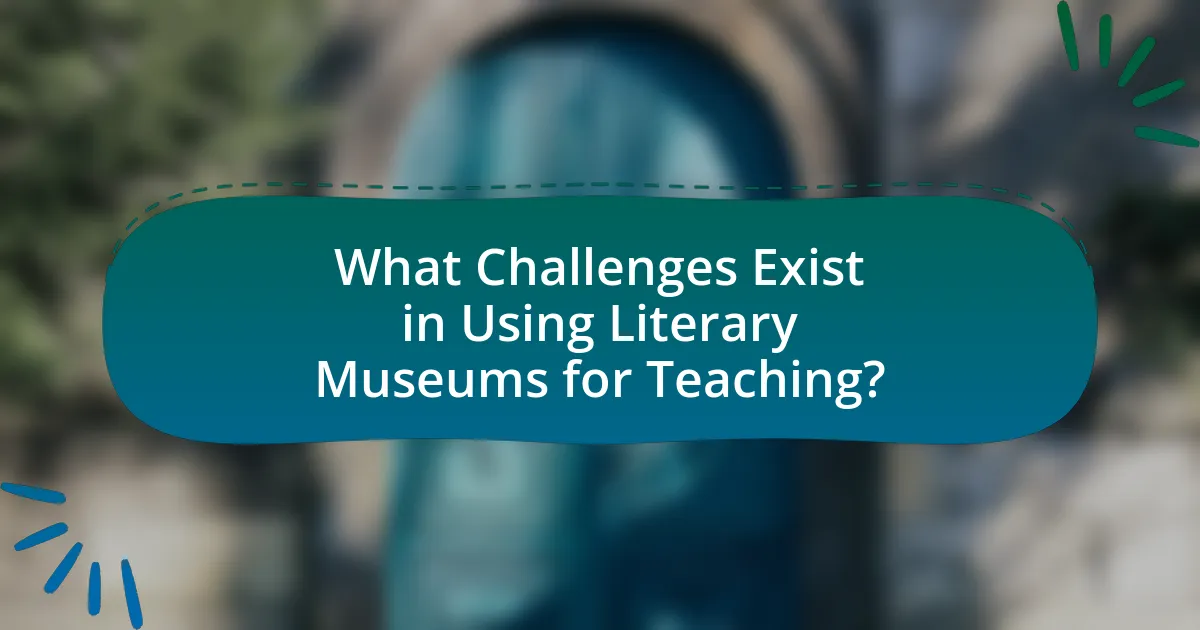
What Challenges Exist in Using Literary Museums for Teaching?
Using literary museums for teaching presents several challenges, including limited accessibility, varying educational objectives, and the potential for misinterpretation of historical context. Limited accessibility can hinder student engagement, as not all students may have the opportunity to visit these museums due to geographical or financial constraints. Additionally, educational objectives may differ between museum curators and educators, leading to a disconnect in the intended learning outcomes. Furthermore, the interpretation of historical context can vary widely, which may result in students receiving a skewed understanding of the literature and its background. These challenges highlight the complexities involved in effectively utilizing literary museums as educational tools.
What are the common barriers educators face when incorporating museums into lessons?
Educators commonly face logistical, financial, and curricular barriers when incorporating museums into lessons. Logistical challenges include transportation issues, scheduling conflicts, and the availability of museum resources that align with educational standards. Financial constraints often arise from the costs associated with field trips, including transportation and admission fees, which can limit access for schools with tight budgets. Additionally, curricular barriers exist when museum content does not directly align with the required curriculum, making it difficult for educators to justify the integration of museum visits into their lesson plans. These barriers hinder the effective use of museums as educational tools, despite their potential to enhance learning through experiential engagement with historical context.
How can these barriers be overcome to maximize educational benefits?
Barriers to maximizing educational benefits in using literary museums can be overcome by integrating interactive technology and community engagement. Interactive technology, such as virtual reality and augmented reality, enhances visitor experiences by allowing them to immerse themselves in historical contexts related to literature. For instance, a study by the American Alliance of Museums found that museums utilizing technology saw a 30% increase in visitor engagement. Community engagement initiatives, such as workshops and partnerships with local schools, foster collaboration and make literary museums more accessible, thereby increasing participation and educational outreach. These strategies effectively address barriers like limited visitor interaction and accessibility, ultimately maximizing the educational benefits of literary museums.
What resources are available to support educators in this endeavor?
Educators can access various resources to support the use of literary museums in teaching historical context through literature. These resources include online databases such as the American Alliance of Museums, which provides educational materials and best practices for integrating museum content into curricula. Additionally, many literary museums offer educational programs, workshops, and guided tours specifically designed for educators, enhancing their ability to convey historical context effectively. Research studies, such as “The Impact of Museum Education on Student Learning” published by the Journal of Museum Education, demonstrate that museum-based learning significantly improves students’ understanding of historical contexts in literature.
What best practices should educators follow when utilizing Literary Museums?
Educators should prioritize interactive engagement when utilizing Literary Museums to enhance learning experiences. This involves encouraging students to actively participate in guided tours, workshops, and discussions that relate literary works to their historical contexts. Research indicates that experiential learning, such as that found in museums, significantly improves retention and understanding of complex subjects (Falk & Dierking, 2000). Additionally, educators should integrate pre-visit and post-visit activities that prepare students for the museum experience and reinforce their learning afterward. This approach not only deepens comprehension but also fosters critical thinking skills by connecting literature to its socio-historical background.
How can collaboration with museum staff enhance the learning experience?
Collaboration with museum staff enhances the learning experience by providing expert insights and tailored educational programs that connect literature to historical context. Museum staff possess specialized knowledge about artifacts and exhibitions, which can deepen understanding of literary works by contextualizing them within their historical settings. For instance, when students engage with museum curators during guided tours, they gain access to unique interpretations and narratives that enrich their comprehension of the literature being studied. This interactive approach fosters critical thinking and encourages students to draw connections between texts and their historical backgrounds, ultimately leading to a more immersive and impactful learning experience.
What tips can help educators create meaningful connections between literature and history?
Educators can create meaningful connections between literature and history by integrating literary museums into their curriculum. Literary museums provide contextual insights into the historical periods that shaped the works of authors, allowing students to explore the socio-political environments that influenced literary themes. For example, visiting the Ernest Hemingway Home and Museum can help students understand the impact of World War I on Hemingway’s writing, as well as the broader cultural shifts of the 20th century. Additionally, incorporating primary sources, such as letters or diaries from authors, can enhance students’ understanding of the historical context in which the literature was produced. This approach not only enriches students’ comprehension of the texts but also fosters critical thinking about the interplay between literature and historical events.
